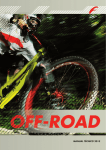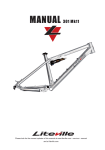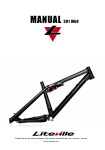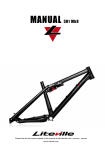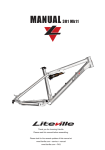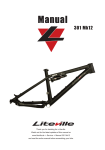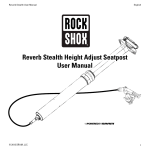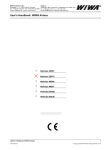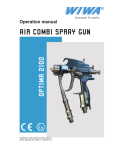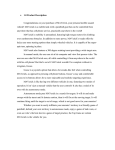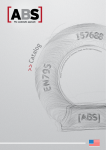Download MANUAL
Transcript
MANUAL 601 Mk1 Please look for the newest updates of this manual at www.liteville.com > service > manual and at liteville.com Limits for the Liteville 601 Frame Please be aware, not all parts available on the market can be used on the Liteville 601 frame and some parts simply should not be used! The following parts have limits: Crank/Bottom Bracket Not all available crank/bottom bracket units can be used. The bottom bracket Look for clearance shell width is 73mm. Make sure the left crank does not collide with the left chain stay. Since the Liteville 601 frame is only suitable for Shimano EType front derailleurs you need a bottom bracket that can be used with one. Wheels/Tires The Liteville 601 frame is compatible with tires up to 2.5“. Seatpost The Liteville 601 frame needs a seatpost with a diameter of 34.9 mm. To prevent frame damage, the seatpost needs to be inserted down to the mark on the seat tube. Frames with Works Finish do not have a laser etching. Nevertheless, you need to adhere to the minimum inserting depth (140mm, see picture on left). N 2 Seat clamp In case you do not want to use the original Syntace clamp you need a clamp with a diameter of 38mm due to the oversize build of the seat tube. Watch for enough clearance of the rear triangle during compression. To test, deflate shock completely and carefully compress the rear entirely. Shifter cable For a trouble-free installation use cable housing with a 4 mm outside diameter, for example Shimano SISSP41. Rear shock / Shock mounts You can use shocks of different eye-to-eye lengths and different strokes. The standard shocks supplied are 222mm with a 63.5mm stroke or 240mm with a 76mm stroke. The resulting travel results in approx. 165mm and 190mm depending on the frame size and chosen position of the shock mount. If you choose to use a shock of different eye-to-eye or stroke length, you must check that all bike components that move are completely free to move and do not collide with any part of the frame throughout the entire movement of the rear wheel! 190 mm 165 mm Caution: Use the enclosed shock mounts for adjusting to the different shock lengths. The 190mm shock mount must be used with shocks of 240mm eye-toeye length. The 165mm shock mount must be used with shocks of 222mm eye-to-eye length. Note: You will have approx. 180mm travel with a shock of 222mm eye-to-eye and 70mm stroke. Tip: Ensure that the wheel is free to move throughout the shock stroke without touching any other frame components (also check the shock itself!) with your selected shock and selected shock mount position. Due to the large travel and additional geometry fine tuning, it is possible that not all settings and component combinations will work without collision. This means, depending on the chosen tyre and relative diameter, frame size, position of the shock mount, the shock and the relative tolerances it is possible for two components to collide. Do not use such a combination as this can lead to damage of frame and components. Hint: A slight brush of the rear wheel at full compression is nothing to worry about. It will damage nothing and may only leave a brush mark on the seat tube. 3 Geometry Fine Tuning Bolt right at the top means: steep head angle and high bottom bracket. The geometry fine tuning option can of course not only be used for general geometry adjustments. You can also adjust the level of sag, without changing the geometry (when rider is mounted). Bolt at the bottom means: flattest head angle adjustment and low bottom bracket. Tip: take a whole day just to experiment and find your personal favourite suspension setup. In combination with the different shock parameters, there is a vast range of possible different setups. Brakes The Liteville 601 frame has been designed exclusively for use with disc brakes. The maximum rear rotor diameter is 210 mm. Dual Crown Forks The Liteville 601 is dual crown fork compatible, but (like the majority of DH bikes) does not have a fork stop integrated in the frame. This means: when using dual crown forks in the 601 you may have dents in the frame in the region of where the stanchions would collide with the frame. Installation Frame preparation The contact surfaces for bearings and brakes etc. have already been prepped at the factory – you do not need to surface anything to install headset, bottom bracket or brakes. 4 Headset / fork The headset bearings have been pressed into the frame by the factory. In case you need to change bearings, do not forget to use grease and make sure the bearings are pressed in evenly and completely. It is best to use a special tool for the task. Fork installation First, install both seals (grey lip on the outside, black o-ring on the inside) on the cover of the SuperSpin headset. Install the larger of the two slotted rings (the base plate, see picture) onto the steerer tube. Insert the steerer tube into the head tube, add the smaller slotted ring onto the steerer tube and install the black cover plate. Make sure the fork does not collide with the frame when turning. Now slide the lower (depending on fork, either the tapered or the 1 1/8” one) of the two slotted bearing cones onto the steerer tube. If using a 1 1/8” fork you now need to install the lower 1 1/8” reducer in the lower bearing (do not forget to grease). Insert fork into the frame, slide upper 1 1/8” cone onto steerer tube and install the cover plate. SuperSpin tapered, lower 1.5, upper 1 1/8 SuperSpin 1 1/8 with reducer for 11/8 steerer tubes Tip 1: Before installing the cover plate, grease bearing heavily. It will keep moisture away and aids easy spinning. Tip 2: Pull the headset tight with the adjustment bolt, then loosen the bolt again. Only now adjust bearing play. With that procedure you can make sure that the bearings have been seated correctly and will spin easily. Make sure the fork does not hit the down tube when spinning the bar. 5 Bar / Stem Install bar and stem according to manufacturer’s instructions onto the steerer tube. Hint: test ride first with uncut steerer tube. You would not be the first person to be ticked off because you cut the steerer tube too short! Shift levers Install levers according to manufacturer’s specifications. Bottom bracket / crank & front derailleur Depending on which type of E-Type derailleur you use, you may need to make it compatible so that it does not collide with the swing arm (see photo). This is not a design error, but a deliberate positioning of the main pivot for best kinematics and stiffness properties. Perform following: simply pre-mount the derailleur and mark the interference area. Now remove the marked area with a file. Liberally grease contact surfaces for the bottom bracket. Fix the E-Type derailleur with the bolt (supplied by Shimano). Important: Do not use a spacer between BB and derailleur. Now install both BB bearing cups according to installation instructions. Use enough grease! From experience we know that especially outboard bearings tend to creak if not enough grease has been applied to the contact surfaces. Now tighten the 5 mm Allen screw of the derailleur according to manufacturers specifications and install crankset. Make sure there is enough room for rotation between crank arms and frame – test for enough clearance. 6 Installation of HammerSchmidt Add the included HammerSchmidt adapter (with a little grease) to the ISCG mount and install the HammerSchmidt crank according to specs. Cable routing for HammerSchmidt In order to create a suitable cable routing for the HammerSchmidt crank, you will need to replace the cable guides on the down tube. First replace the right hand single cable guide with a previously further down mounted double cable guide. The Hammerschmidt gear cable is then routed parallel to the rear gear cable on the outside and under the front shock mount. Replace the double cable guide which is still mounted to the down tube with the triple cable guide which is supplied in the Hammerschmidt Kit. After routing the Hammerschmidt gear cable under the rocker arm, the cable is routed straight to the housing of the Hammerschmidt crank. Please also replace this cable guide with the optional triple cable guide. Caution! Please only tighten the cable guides with a low torque as marked on the frame. If you want the Hammerschmidt cable to be aesthetically perfectly aligned you can use a piece of shrink tube (best is thick wall type such as from Hellermann Tyton) to keep the cable snug against the rear gear cable in the lower down tube area. 7 Cable routing for front derailleur (without HammerSchmidt) Before you can install the cable housing, you need to unbolt the front shock mount and fold down the shock. To mount the cable housing, you will find special mounts on the bottom side of the top tube. Proceed as follows: Sharply bend a zip tie about 10 – 15 mm behind the tip so get something close to a hook. Now insert the hooked zip tie into the cable mount. Make sure you insert only far enough so the tip snaps over the little cross ridge. By pulling and pushing, you can direct the zip tie all the way through until the head is at the top tube. Now you can install the cable housing (and the optional cable housing for an adjustable seat post. Note: only pull the zip tie tight by hand! Cut the zip tie right at the head and turn the heads all the way to the top tube so they do not stick out. 8 In order to guarantee long lasting proper smooth function, the gear cable housing for the E-Type derailleur should be routed in a not too direct fashion, but it should also not be too long so that it bows out and creates unnecessary bends. Cable routing for the rear derailleur The shifter cable for the rear derailleur is being routed directly through the seat tube into the chain stay. To protect the cable even better from corrosion, we use an additional, flexible tube. Hint: Do not remove the transparent plastic tube. In case you did remove it, reinstall it by pushing it thoroughly into its seat (blue in the picture) and do NOT use lubrication. The exit for the shifter cable is at the lower end of the right chain stay. 9 Routing of brake line The brake lines and shifter cables are being routed continuously. Please to not over-tighten the bolts of the clamps to avoid crimping. If crimped, shifting and braking lines will lose function. Be aware that the brake line will be shortened during compression. Leave it long enough! Use the included clips for mounting the brake line on the left chain stay. If you use zip ties, squeaking noises may occur. Be aware: The routing pictured is for brake callipers where you can turn the line towards the rear. It will vary with other brake models. The rear brake line is routed underneath the rocker link! You have two assembly options. The simplest option is: For the case that the rear brake line is too long and requires shortening anyway, then guide it through the gap between the down tube and rocker arm when shortening the brake line and no brake calliper is attached. Caution: both rocker arm bolts are factory pre-assembled as many riders prefer the second option described below. Therefore, you must still follow the instructions from point 4. onwards below to grease and secure the bolts. 10 The second option is: 1. Remove the shock. 2. Now the rocker link needs to be removed from the down tube. Undo one of the two black alloy bolts with a 10mm hex key. After removal of the first bolt with a 10mm hex key, the second bolt can be removed by holding the other end of the pivot assembly with a 14mm hex key. 3. Now the brake line and calliper assembly can be routed underneath the rocker arm. The rocker arm and shock can now be assembled again. 4. Be careful the thread of the bolts does not get damaged and ensure they get a good initial grip. Lightly grease the bolts on the shaft (and on the two conical spacers on the lower shock mount). Do not grease the thread on any of the bolts. Instead, apply a drop of thread locker such as blue Syntace Bond 48 (medium strength) to the thread. Rear derailleurs from Shimano: All derailleurs starting from model year 2009 will work (only Shadow!). Installation of old derailleurs (with the large diameter housing bend) is not recommended on Liteville 601 frames because they do not harmonize well with the new, low-profile routing. Rear derailleurs from SRAM: SRAM X.7, X.9 and X.0 will fit - as well as all older SRAM rear derailleurs. 11 Reasons for preference of newer Shimano and SRAM derailleurs: •D irect cable routing without unnecessary arcs •B etter protection against branches •R educed friction by avoiding large radii •N o crashing of derailleur against chain stay •R educed noise Install and adjust the derailleur according to the manufacturer’s specifications. Attention: For perfect protection, install the optional Syntace RockGuard II. There are different models for SRAM, Shimano Shadow and Saint models. Tip: There is a sticker included for the front derailleur. Install it as pictured to reduce chain slap at the front derailleur. Saddle, seat post and seat tube Check the seat tube for edges and burrs. Remove them with fine sanding paper before inserting the seat post. Attention: If fully inserted, the seat post may reach the “dent” for the E-type front derailleur. If you try to force it any deeper, you may damage seat post and/or frame. Attention: Observe the “minimum insert” mark at the seat tube as described in the chapter about limits. Tip: Cut the seat post to the “minimum insert” dimension after being sure that it works well. That way you can lower the seat post to the max. Attention: Take note of the seatpost’s wear limit. When frequently adjusting the height of your seatpost in muddy or dusty conditions, material wear actually takes place on the surface of both the seat tube and seatpost. The wear on carbon seatposts is much higher than on alloy seatposts due to the coated resin matrix/fibers used. To keep this wear to a minimum, we recommended removing the seatpost from the frame after every ride in wet/muddy conditions and then to clean it. The inside of the seat tube should also be cleaned with a rag. Check the diameter of the seatpost from time to time. At no position along the post, the diameter is allowed to become less than 34.7mm! If this is the case, the seatpost requires replacing to prevent the frame from being crushed resulting in possible deformation or cracking in the clamping area. 12 Caution: the use of seat post shims still requires adhesion to the minimum insert depth as required by the frame! And what is the required length of seatpost in the shim? The use of seat post shims still requires adhesion to the minimum insert depth of the seat post! Build-in interfaces Adjustable seatpost with remote The Liteville 601 Mk1 is ready for installation of an adjustable seatpost with remote actuation. Optimum function is only guaranteed for posts where the cable is mounted at the seat clamp area and not at the head. Use only cable housing with an diameter of 4mm (for example Shimano SIS-SP41). Syntace SCS Chain Guide Integrated connections for the patented Syntace SCS chain guide are standard at the Liteville 601. The future Syntace SCS chain guide offers low weight and an unknown precision coupled with reliability for single, double and triple cranks. 13 Maintenance and care Bearings All bearings used are greased for life and do not need to be disassembled to be repacked with grease. In case of a defective bearing you can order a new bearing from your dealer or from Liteville. When cleaning, do not let a strong jet of water enter the bearings (see section “washing”). Too much assumed “care” can reduce the bearing life by more than 20 000km of riding. Headset In case you need to change the headset you can order a new one through your dealer or from directly Liteville. Bolts All frame bolts used are high-tensile strength titanium bolts. They have been manufactured especially for our Liteville frames. In case of loss or damage you can order them through your dealer or from Liteville. On all frame bolts a thread lock has been applied, so make sure you heat them with a hot air gun if you want to disassemble them. Use a thread lock (like Syntace Bond 48) when reinstalling! From time to time make sure all bolts are still tightened– torque values can be found laser-etched onto the frame on black anodized frames. You will also find torque values in the rear of this manual. Hint: Sometimes one needs to do the opposite of what one expects…for example, if it creaks up front, grease in the rear. The suspected creaking from the bottom bracket might not be caused there at all. Leave the BB alone and try this first: •R emove cassette •A pply copper paste thoroughly to rotor surface •A fter re-installing cassette tighten with full torque Washing Never use a high-pressure washer to clean your frame! The high water pressure will force water into the bearings and premature corrosion and wear will follow. Dirt, blown away by high water pressure, will scratch the surface and mar it permanently. Additionally, do not use a garden hose water jet (or similar) on any of the frame pivot points to remove dirt. Instead, (if necessary, together with brush or sponge) clean pivot points only with water from a bucket or a hose with nozzle set to soft spray setting. To clean your frame, first use water from a hose and then a soft sponge with warm water, preferably with a few drops of dishwashing detergent. Dry frame with a soft cloth. To achieve a nice sheen, use silicone spray and wipe with a soft cloth. Important: make sure the silicone spray does not reach your brakes or rotors. Almost complete loss of braking power will be the result if silicon contaminates brakes. In case brakes are contaminated, clean rotors with brake cleaner and install new brake pads! 14 In addition to the available surfaces race black anodized and your custom color in powder coat, we offer in every production run a limited edition of Works Finish frames. The new Liteville Works Finish is a genuine raw aluminium surface, no imitation. You can see the irregular marks of the manual work. Changes of surface color and stains are standard with this finish. Over time it develops the charm of natural patina on the Works Finish frame. The surface can be re-worked anytime with Scotch-Brite or can be coated. You will find two Scotch-Brite pads included with every Works Finish frame. Please try their effectiveness in an area not immediately visible to make sure you will like it. Logos on Works Finish: You will find two logos cut from 3M material with the frame. If you stick them onto the frame analoguous to the anodized frame or in a different fashion – it is yours to decide! 15 Changing a shifter cable housing • Leave the transparent tube in place •C ut the new cable housing in a skewed fashion • Spray a little silicone spray into the guide tube • Insert shifter cable from the front until it is at the chain stay yoke • Use the rest of the cable housing as a handle by rolling it up. Let the housing find its way by turning and pushing at the same time. It will work even easier if the rear triangle will be moved up and down by about 1 – 2cm (remove shock mount). •P ush further until the housing hits the Horst link and let it find its way though the hole by turning and pushing •N ow cut the ends of the housing as usual. Done! 16 Setup Adjusting shock preload: For optimal performance we highly recommend spending some good time to set the suspension up correctly. Proceed as follows: •P ush the O-ring on the shock body right back against the shock seal. •N ow, place one foot on the first step of some stairs and carefully get on the bike with your full riding outfit (including helmet, riding shoes, full backpack etc.) without any unnecessary weight shifting or “bouncing”. • Carefully get off the bike without any further compression of the shock and check where the O-ring is. •M easure the the distance between O-ring and shock seal. • Depending on riding style, shock used and personal preference, the O-ring 20-40% should be 20-40% of thew stroke away from the shock seal (see diagram). • If the distance is greater, add some air into the shock. • If the distance is less, release some air from the shock. Caution: even a backpack or hydration back pack will change the applied load on the suspension set up to the extend that it will require readjusting of the shock air pressure. Setting Rebound Speed: •R ide off a kerb at average speed while seated. After the initial impact, the suspension should only “oscillate” once. • If the suspension is too fast (the suspension oscillates multiply after initial impact) then increase the rebound dampening. Please take note: the suspension should also not rebound too slowly, otherwise the suspension will “harden” while riding over many small consecutive bumps. Please also take note of the shock manufacturer’s owner’s manual. 17 18 10-20 Nm X-12 Achse 10 Nm 10 Nm 6 Nm 6 Nm 10 Nm 6 Nm 10 Nm 25 Nm 10 Nm 15 Nm 10 Nm 10 Nm Always use a torque wrench such as the Syntace Torque Tool to tighten any bolts. green: heavy duty thread lock blue: medium duty thread lock white = without duty thread lock Tight bolts only very smooth 1 Nm Maximum torque 19 Horst Link Lager Lager Sitzstrebe/Wippe assumed “care” can reduce the bearing life by more than 20 000km of riding. Schwingen-Hauptlager Gleit-/Nadellager in Dämpferaugen When cleaning, do not let a strong jet of water enter the bearings (see section “washing”). Too much that no loctite flows into the bearing seal. loctite between bearing race and frame bearing seat sparingly. Please pay special attention so To do this, degrease the bearing seat with a cleaning alcohol. Then, using a cotton bud apply the tite, Syntace Bond 48 Hochfest). If replaced, the highlighted bearings must be assembled using a high strength loctite (for eg. Loc- Lager Wippe/Unterrohr green: heavy duty thread lock blue: medium duty thread lock white: without thread lock Bearings with Loctite Syntace GmbH Am Mühlbach 5C D - 87487 Wiggensbach Tel. +49 (0)8370 929988 Fax +49 (0)8370 929888 [email protected] Sales for Germany, Austria and Switzerland: Syntace GmbH Dammweg 1 D - 83342 Tacherting Tel. +49 (0)8634 66666 Fax +49 (0)8634 6365 Current: 26.03.2012 20 [email protected]





















